Discovering Vrindavan
“My aversion to sentamentalism and blind faith went right to the core of my stonelike heart. Yet in Vrindavan we got our first inkling that there might be something higher than the mind, higher than arguments and speculation.”
by Visakha-devi dasi
One evening in March of 1971, my husband John and I were sitting with His Divine Grace A.C. Bhaktivedanta Swami Prabhupada in his airy room in Bombay. It overlooked the city’s modern skyline on one side and the Indian Ocean on the other.
“We want to do a photo essay on an Indian village,” John ventured, disclosing a dream we’d had after reading National Geographic articles about beautiful, quaint places in far-off lands.
Srila Prabhupada looked at us with what seemed a mixture of gravity and amusement. “Wherever you go,” he said, “they will simply cheat you and steal your equipment. You don’t even speak the language.”
Somewhat stunned—no, crestfallen—we sat silent and still.
Srila Prabhupada paused and continued. “Best that you go to Vrindavan and take your photographs there.”
There were other guests in the room, and Prabhupada turned his attention to them. After a short while we excused ourselves and left.
I don’t think I had heard of Vrindavan at that time, although John had. Vrindavan is a small village, with a population of some thirty thousand, and it’s located ninety miles southeast of Delhi. Ancient Indian histories say that when Krishna, the Supreme Personality of Godhead, comes to our universe (once every 8.64 billion years), He comes there with His friends and associates.
At first, we weren’t exactly enchanted with the idea of going to Vrindavan. Instead, we went to Nepal for a couple of months and trekked around in the Himalayas. At twelve thousand feet we found a small cowshed where for three or four days we read Srila Prabhupada’s Bhagavad-gita As It Is. Once back in India we wandered some more, meeting Prabhupada’s disciples now and then and reading another book of his, Teachings of Lord Caitanya, as we went. When we finally reached New Delhi, we boarded the Taj Express, got off at Mathura Station, and late at night climbed into a typically rickety old bus that would take us to Vrindavan, seven miles to the south.
Fifty centuries ago Lord Krishna had made a somewhat similar journey. He took His birth in Mathura, and that night His father Vasudeva carried Him to Vrindavan through a raging storm. Of course, our journey between the towns was much less difficult. Normally the buses are packed with people, but because of the late hour we had plenty of room, even for our backpacks. It was July by now and the air was quite warm, though it was after midnight. I remember that the noisy bus roaring down the streets seemed incongruous in such a serene atmosphere. That first night we rested near the doorway of an asrama that was locked, and by the next day we had rented a small three-story house at fifty rupees (about six dollars) for one month.

If there was ever a turning point in our lives, this month in Vrindavan must have been it. John had always been neutral on spiritual matters, but I was an avid atheist, so much so that I had converted some of my friends to my way of thinking. My aversion to sentimentalism and blind faith went right to the core of my stonelike heart. Yet in Vrindavan we got our first inkling that there might be something higher than the mind, higher than arguments and speculation.
Every morning I would go to the market to get yogurt and fresh fruit for our breakfast. As I walked along snapping pictures in the sunny streets, people would greet me with jaya radhe (“All glories to Radha”; Srimati Radharani, I found out, is Krishna’s dearmost consort). The two-block walk took me past two of Vrindavan’s seven major temples:
Radha-Ramana and Radha-Gopinatha, each built by one of the renowned Six Gosvamis. At that hour the sound of temple bells filled the air, along with songs about Krishna. The people hurried from one temple to another for darsana (the opportunity to see Krishna’s sculpted Deity form), white monkeys, famous as Krishna’s pets, mischievously observed the goings-on and waited to steal any unguarded eatables.
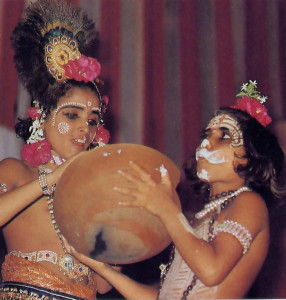
In our daily walks John and I came upon thousands of temples—Vrindavan has no less than five thousand, and there’s hardly a street without at least one. Krishna’s Deity forms were all over, not only in the temples but in the shops, which also specialized in pictures, murals, and Deity clothing and ornaments. Everywhere I saw Bengali widows who were spending their last days in Vrindavan. I used to photograph them, several hundred sitting together in the morning and chanting the maha-mantra (Hare Krishna, Hare Krishna, Krishna, Krishna, Hare Hare/ Hare Rama, Hare Rama, Rama Rama, Hare Hare).
We visited the places where Krishna once displayed His extraordinary pastimes: the bathing ghata where He killed the Kesi demon, the tree from which He pounced on the Kaliya serpent, the forest alcove where He met the cowherd girls in the dead of night and danced with them. Not that we accepted these accounts or the philosophy of Krishna consciousness, but Vrindavan definitely had a different atmosphere. There was no way to get around it.

All these impressions influenced us, no doubt, but what had an even greater influence was meeting Srila Prabhupada’s disciples who had come to the holy land on pilgrimage, Here were young, educated Americans who were sure that God exists and that Krishna is God. I remember that John and I walked on the six-mile path around Vrindavan with Brahmananda Svami, one of Srila Prabhupada’s first disciples, who spoke lovingly about his spiritual master. A devotee named Giriraja (now Giriraja Svami) was always talking about Krishna’s pastimes with great sensitivity and enthusiasm. And there was Yamuna-devi dasi, one of the warmest, most friendly persons I’d ever met. One especially hot day, she and I sat up to our necks in the Yamuna River (the water buffalo do likewise), and we talked about Krishna consciousness and the things Krishna had done right there some fifty centuries earlier. After a while, I started seeing that I was an atheist mainly because my parents were atheists and no one had convinced me to be anything else. What Yamuna said was surprisingly simple. No, I’d never experienced a living thing coming from nonliving matter. No, I’d never seen any machine or building or plan of any kind that didn’t have someone behind it, some person who had thought it out.

Yamuna didn’t really care much for debating, though. I noticed that she preferred serving Krishna and His devotees, and that she was very attracted to Deity worship. One day she humbly asked John if he would donate some money for purchasing beautiful brass Deities of Radha and Krishna that she had seen in a shop. I think she was as surprised as I when he smiled and said yes. She was overjoyed, she said now she could serve Krishna better. And she explained that for God there’s no difference between spiritual energy and material energy, because both energies come from Him. So, she said, since people in this world can’t see Krishna’s original spiritual form, Krishna comes before them as the Deity. Then they can express their love for Him by bathing, dressing, and ornamenting Him and offering Him food, just as a parent cares for a child or a lover cares for the beloved. Yamuna had been personally taught by Srila Prabhupada in the art of Deity worship, and now she started caring for her Deities in that way.

There was something else about that first stay in Vrindavan that pushed John and me along in spiritual life—our suffering. We had contracted glaucoma, an infection of the eyes that makes them itch and tear continuously. At a devotee’s suggestion John bathed his eyes in the Yamuna River and got rid of it, but I decided to slay home, flat on my back on the second floor of our house, underneath a mosquito net (to protect me from the flies). The heat was intense, the tearing of my eyes made me blind, my hayfever had started up, and my nose was running in between sneezes. What a mess. I recalled that Srila Prabhupada had written that this material world is miserable, and I could see clearly that it’s hardly an ideal place to live in.

From April to October, 1971, Srila Prabhupada went on a speaking tour through Europe and America. When he returned to Vrindavan, we came back from a visit to Calcutta and stayed with him in a large house that someone had lent to his disciples.
Every morning we attended arati (a ceremony for greeting Krishna with singing, dancing, and offerings of food), and later Srila Prabhupada would lecture on the science of Krishna consciousness. After breakfast each day we would climb into a big bus, and Prabhupada would give all of us a tour of the holy places: Varsana, where Radha appeared; Govardhana, the hill that Krishna lifted to protect the townspeople from a torrential rain, Nanda-grama, where Krishna grew up; and Brahma-ghata, where Krishna opened His mouth to prove to His mother that He had not eaten dirt. When Mother Yasoda looked inside the Lord’s mouth, she saw the entire creation, and when Prabhupada related this pastime, his eyes opened amazingly wide.

Prabhupada was so convinced: “If you accept God, then you have to accept the inconceivable potency of God, You can’t make Him fit your limited ideas—if you do, that means you actually don’t accept God. God can do as He likes, when He likes, and where He likes. Why can’t Krishna lift a hill or display the creation in His mouth? Because you can’t He can’t?”
In every way Prabhupada made Vrindavan come alive. To be with him there made everything take on a new significance; his eyes were anointed with pure love for Krishna. We could see that Prabhupada worked eighteen or twenty hours a day for Krishna, not worked, exactly, but served with love and devotion—preaching, writing, instructing. It was obvious he didn’t want fame or profit; he didn’t want any material enjoyments. He simply never saw anything that didn’t remind him of Krishna, so he was always enlivened and he always enlivened us, with his ready wit, his insight, his foresight, his profound realizations, his purity, his determination.

In October Srila Prabhupada initiated John as his disciple, but at that time I was still a little too doubtful. Yet on November 29th, 1971, my doubts ebbed enough for me to receive initiation, too. In front of Srila Prabhupada and the Deities of Radha and Krishna (the same ones John had given Yamuna a few months before), I promised to abstain from meat-eating, illicit sex, intoxicants, and gambling, and I promised to chant sixteen rounds of the Hare Krishna mantra daily. (Devotees chant on wooden beads, and one “round” means once around the 108-bead string, with a mantra for each bead.) Prabhupada looked at me and said, “Sixteen rounds is the minimum.” In other words, I should always try to remember Krishna by chanting His names, not forget Him after I’d finished the prescribed number of rounds.
For almost the entire next year, Srila Prabhupada was away on a world speaking tour, but by October 1972 he had come back to Vrindavan. This time the devotees lived in Kesi-ghata palace, right on the bank of the Yamuna. Every morning at 3 a.m. a few of the more hearty women would rise and slip out the back door of the palace, down some steps, and into the calm water for our morning bath. Then we went back to the palace and had time to chant some rounds before the drati celebration at 4 a m
By 4:30 the celebration was over, but our chanting and dancing continued. With karatalas (small cymbals) and mrdanga drums in hand, we spilled out into the dark winding streets. Acyutananda Svami, one of Prabhupada’s older disciples, led our predawn procession, and at that hour it was a little treacherous—we couldn’t even see where we were stepping. But soon the morning sun’s first glimmer would light our path.
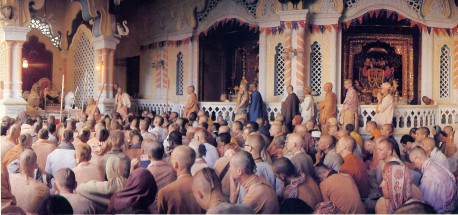
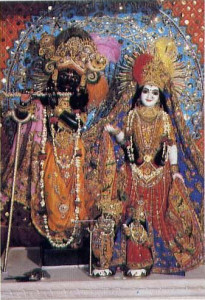
October-November in Vrindavan is harvest time, the most auspicious time of the year. It was during the month Karttika, as it’s called, that mother Yasoda caught Lord Krishna stealing butter and tied Him to a grinding mortar to restrain Him. A few years after this, Krishna danced with the beautiful gopis, the cowherd girls whose pure devotion for Him knew no bounds. Once Krishna told a friend, “The most opportune time is the full-moon night in autumn, like tonight. The best place within the universe is Vrindavan, and the most beautiful girls are the gopis. So, I think I should now take advantage of all these circumstances and engage in the transcendental rasa dance.”
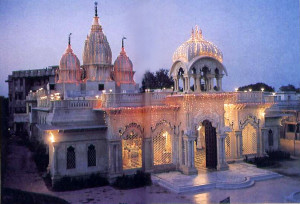
We could appreciate why Krishna enjoyed this time of year. As we played our instruments and chanted along the streets, we practically floated through the cool morning air. With the monsoon rains just past, the foliage was lush and deep green, and all around us we saw freshness and new life.
Each day we went to Ramana-reti, on the outskirts of the town. Ramana means “pleasurable,” and reti means “sands.” Srila Prabhupada called Ramana-reti “the shimmering silver sands” where the Lord enjoyed His pastimes as a cowherd boy. In this area someone had given Prabhupada a plot of land, and construction was underway for the Krishna-Balarama Temple and International Guesthouse. A few devotees were living there and overseeing the construction, and each morning they would greet our small party warmly and show us how the work had progressed since the day before. (At that time there were just giant holes in the ground.) Then we would start back toward town, chanting Hare Krishna quietly as we walked along. By now we could hear the calls of the peacocks, and we could often see them perched in the trees or running about on their long legs. There were many other less spectacular birds, also, each with its unique song. And there were donkeys hauling huge loads, monkeys frittering away their time, camels eating thorny twigs, hogs acting as sewage disposal units, dogs fighting and whining, horses pulling carts, and hundreds of white cows strolling peacefully to pasture.
Seven o’clock found us seated in the courtyard of Radha-Damodara temple, which was founded by Srila Jiva Gosvami. A great scholar and philosopher, he proved through his brilliant writings that ancient India’s Vedic literatures point to Krishna consciousness as life’s ultimate goal. The Gosvamis used to sit together in the temple’s courtyard to study and discuss the science of Krishna consciousness. Rupa, the foremost Gosvami, had his bhajana-kutira (place of worship), in this courtyard, and his samadhi (tomb) is there as well. Perhaps more significant for us, Srila Prabhupada had made this temple his headquarters from 1956 to 1965, before he left India to teach Krishna consciousness in America. It was here that he started his masterpiece, his English translation and commentary on Srimad-Bhagavatam. Srila Prabhupada’s room overlooked the courtyard where the Gosvamis used to sit, and he derived great inspiration from this sacred place.
Now, in 1972, Prabhupada was again occupying his old rooms, and at 7 a.m. he would sit with us in the courtyard and lecture from the Srimad-Bhagavatam, First Canto, Second Chapter: “Divinity and Divine Service.” This chapter summarizes the whole range of spiritual and material knowledge, and in a poetic way it presents all one needs to know to become fully happy and successful in this life. Prabhupada would speak for forty-five minutes to an hour. The words that flowed from his lips were filled with devotion and wisdom and held us in rapt attention.
Afterward, there was a light breakfast (yogurt, puffed rice, and fruit), and then we set about our daily activities. Usually, I went with some other devotees to photograph the local temples. By one o’clock we returned to Kesi-ghata palace for a substantial meal: sabji (spicy vegetable preperations), dahl (bean soup), rice, and milk sweets. Then there was time for some reading and discussions, and a nap. By five we had the transcendental emotions devotees experience in relation to their Lord, Sri Krishna.
After this lecture, whoever wanted to could squeeze into Prabhupada’s small room to hear further discussions and ask questions. There was so much to learn. Prabhupada could speak for hours, and we could listen for hours without feeling fatigued. “Krishna is a person, the Supreme Person, and you are a spirit soul, part and parcel of Him. This material world is not our real home. Our real home is Vrindavan—the original Vrindavan, in the spiritual world. There we can eternally pass our time with Krishna and His associates in a blissful, loving relationship.” This was the essence of the philosophy, and there were innumerable ramifications.
Logic, we found, is like a cake which has been left out to become thoroughly dry and stale. My husband and I had passed our lives eating such dry cakes, but Prabhupada made us drink the nectar of Krishna’s transcendental pastimes. By sending us to Vrindavan in 1971, Srila Prabhupada had prepared us for entering a new life. And when we took initiation from him, our new life began. Now he was showing us how to extricate ourselves from our material attachments. He was gently bringing us into an ever-fresh, ever-personal world where we had a fulfilling role to play, a world where all our desires were satisfied just by our cooperating with the Supreme Person who resided there, a world based on pure love.
And it worked—it was practical and immediate. Our small group in Vrindavan felt great harmony and unity of purpose. We simply let Krishna be the center of our lives. We sang for Him, we heard about Him, we offered Him our food, we visited the places of His pastimes and remembered His activities. We felt united in serving Him, and very happy. Krishna consciousness was not a Utopian dream, not mythology, but something real and tangible.
The year 1975 found my husband and me in Vrindavan again, this time for the grand opening ceremony of the Krishna-Balarama Temple and International Guesthouse. When we’d come to Vrindavan four years earlier, we’d had no place to stay, no knowledge of the area, and no friends. Now Prabhupada had provided all of that. And through his temples, his disciples, and his transcendental books, Srila Prabhupada is introducing everyone to Vrindavan, just as he introduced us.


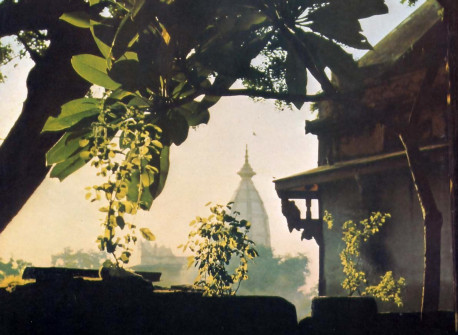
Respected Mataji,
It was truly a stupendous journey to have read this article. Especially the incidents and facts related to Radha Damodar Temple gave me immense pleasure. After reading this article, my heart is yearning again to visit Sri Dham Vrindavan in coming Kartik Masa with a fresh new insight about Sri Krishna Balaram Temple and Radha Damodar Temple. All glories to Srila Prabhupada and all his followers like you.
Hari Bol.
Your Servant,
Nrsimharupa Das,
ISKCON Pune Congregation
Wonderful story!